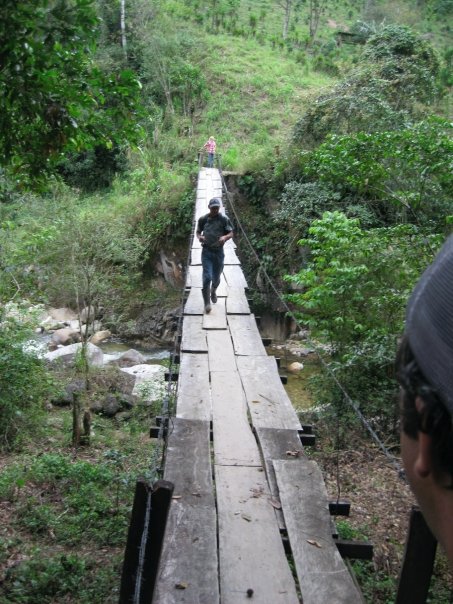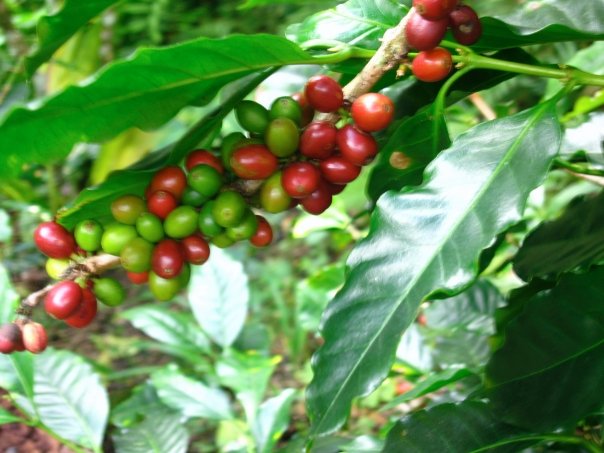Our Blog

A Roaster’s Eye View of Honduras by Ted Vautrinot, Kean Coffee
Lush mountainous rainforest, beautiful warm people, countless hectares of coffee, miles of rutted dirt roads, stunning Mayan antiquities; I experienced all these just days ago on my trip to Capucas, Honduras. I made the journey to view the coffee production firsthand and evaluate this year’s production at the cooperative. I found people that live a life I’d never imagined- difficult yet joyful and built on a commitment and love for producing coffee that continues to improve in quality.
Little Feet, a non-profit whose mission is to provide soccer equipment and instruction all over the third world, made the trip possible. The private label coffee we roast for Little Feet is from this particular cooperative in Capucas. Trevor, Brittany, Errol, and Akrom brought the soccer, while I brought my cupping spoon.

Luis teaching Trevor to Cut Coffee
De-planing at San Pedro Sula, we piled into a minivan for the six-hour ride to the village. Capucas rests at 1,100 meters (about 3,500 feet) elevation in a mountain valley 15 miles from the nearest paved road. I could feel the heat and humidity fade with every meter we rose. The last hour we pitched and bumped along the dirt track to Capucas, a true Honduran massage.
A walk through the village the first morning revealed a collection of low-slung homes, many with dirt floors, each with a concrete drying patio set aside for coffee. Inside the women cooked on wood-fired stoves, grinding the corn for masa and making tortillas for each meal all by hand. Domed wood-fired ovens for baking (delicious pan dulce) stood behind most homes. The children crowded the fence of the school courtyard to catch a look at the gringos and ask about the soccer equipment. Although these people are also butchers, builders, and teachers they are first coffee farmers, the entire focus and economy of Capucas is centered on coffee.
The harvest was mostly finished at the lower altitude of the village, so we set off for Pablo’s, up in the mountains, to cut (pick) some coffee ourselves. Carlos took us to the end of the track in his pickup, the ubiquitous Toyota 4-wheel drive. From there we’d have to hike in, four miles of steep, muddy, slippery trails over two rickety suspension bridges. I marveled at the realization that to deliver his coffee to the cooperative, Pablo hikes this same dangerous trail while leading a mule loaded with four bags of parchment beans. Every brick, board, tile, and piece of equipment that makes his home and living on the mountain was walked up the same way. The solar panel on the roof provided just enough juice for a portable radio and Pablo’s cell phone, his only link to the village below. After a much-needed rest and some soccer for Pablo’s two adorable daughters, 5 and 3, we left the hospitality of his wife and family to cut coffee, about “five minutes away”.

An hour later found us finally at the harvest, Catura coffee growing wild on the steep mountainside under the dense canopy and choked with brambles and fallen timber. It was a challenge to remain upright, much less to maneuver close enough to select the red, ripe cherries from between the green cherries not ripe yet. An hour of concentrated cutting yielded us ¼ of a small basket of cherry each, while the eleven-year old girl cutting along with us nimbly bagged three times as much in the same time.
Returning to Pablo’s home, we loaded the cherry into the pulper and cranked it by hand, he uses a small gas engine for larger amounts. The fruit and skin fell into the compost pile while coffee beans, still in mucilage and parchment, dropped into the wooden tank for fermentation. The next day he’d wash the beans and begin the drying process. Our afternoon’s work would yield about 6 pounds of green coffee for the five of us combined.
We slogged our way back to the trailhead where Carlos’ twelve-year old son Carlitos waited with the truck. With his 4’6” frame, his feet barely touched the pedals, yet he had no difficulty negotiating the twisting rutted track while talking on his cell phone and calling out to the local girls simultaneously. Western culture is making inroads.
Back at the cooperative the pulping process was humming along, huge mechanical pulpers spitting beans into concrete-lined fermentation tanks for a day, then releasing them into washing channels before being spread onto the ½ acre of drying patio to be hand raked and dried. For extremely wet weather there were two mechanical dryers, but they weren’t needed today.

drying coffee
In the lab the cupper and roaster, (another) Carlos, had prepared a cupping of six micro lots and one mélange for us. The coffee was still quite new and not rested, yet cupped out quite nicely with chocolate and caramel sweetness and mango and apricot acidity, with one exception- Carlos snuck in one example of a two-year old coffee just to make sure we were paying attention and scoring honestly. We discussed with Omar (the leader of the cooperative) and Becky (the peace corps volunteer) the challenges facing the farmers, the biggest being the need to impress upon them the importance of picking only the completely ripe cherries to unlock the depth and sweetness inherent in their coffee. Each year Capucas coffee has improved, and this year’s harvest shows fine potential.
The next two mornings found us on the local soccer field, organizing 150 excited kids into groups for basic drills, fast-thinking exercises, and pick-up games. The kids were delighted and eager to please, following Omar’s translations of Akrom’s instruction energetically, and sometimes comically. The kids, and adults, seemed completely grateful for the attention and the scores of balls and equipment distributed. Our last night Britt and Trevor organized a bonfire, teaching the kids to roast marshmallows just the right amount to make S’mores (the amazing norte-americano delicacy), while Errol and I jammed on guitars we’d brought with Luis and Luis. At the end of the night we said our good-byes and Errol presented the guitars to our musician friends to keep. Luis, the pastor of one of the two churches in the village, was particularly touched by the gift.

Capucas Campfire (Ted playing guitar in red shirt)
The next morning we headed out early, the rest of the group for the airport at San Pedro Sula while I jumped out half way there to catch a ride to the Mayan ruins at Copan. I spent the entire day soaking in the energy of the beautiful, massive architecture and intricate hieroglyphics of a culture that rose, flourished, and faded over 1600 years ago. The early temples became the foundation for the next, larger temples as the structures grew in size and complexity over 400 years’ time. The Hieroglyphic Stairway stretched upward imposingly, the largest single collection of written history in all of Meso-America. Just a hundred years ago the entire complex was still swallowed by the jungle around it, years of patient study and restoration have brought it back to a shadow of it’s former splendor. Meditating quietly, I could easily picture the throngs of Mayan people inhabiting the courtyards, playing at the ball courts, worshipping at the temples, breathing life into the huge stone edifices.
As the plane left Honduras late the next day I reflected on the people whose labor make this country and their coffee. Their warm joy and enthusiasm permeate all they do, and I am grateful for the opportunity to share a taste of their experience.


Comments
Thank you for the story of your adventure to Honduras, especially the reminder of all the labor and difficulties farmers face to bring us the bean. As conditions change throughout the world, we coffee folk need to remember how blessed we are by the fruits of their labor.
Chad
What a beautiful picture you paint of a lovely and very different culture. It makes one feel as if you are truly there! I am reading this great travelogue & lusting for the coffee on the 12th of March. Thinking of you all and my most pleasant visit to your Tustin shop for roasting, cupping and lattes!
Ted, your looking good. Looks like a regular Honduran hoedown. Looking forward to trying your coffees. Stay well.
Hello Ted! Thanks for your vicit to Capucas.
We apreciate your time and hope that return soon.
You are a great cupper and excelent playing gitar.
Ted,
Thanks for sharing this blog with me. Your trip looks better than great. Honduran people are so welcoming and loving. My home away from home. Look forward to reading many more blogs of your experiences in the coffee countries. Thanks for all the roasting you do for me!
You’re an artist through-and-through (music, roasting, writing [that’s probably just the beginning]). Thank you for this story! I hope you’re well!
Great Article, the culture the trip must of been wonderful and exciting. Meeting new people sounds like they really are good people compare to what hardship follows down in S.A. Thanks for sharing your trip and experience.
Q linda mi tierra querida y mis paisanos sigamos adelante cuidemos